Cross-Modal Insights into Urban Green Spaces Preferences
Abstract
1. Introduction
2. Site and Data Collection
2.1. Site and Sample Selection
2.2. Data Sources
2.3. Data Cleaning
2.4. Research Design
2.5. Research Methods
2.5.1. TF–IDF Keywords
2.5.2. Image Object-Detection Model
2.5.3. Calculation of Cosine Similarity
3. Results and Analysis
3.1. Landscape Preferences in Text
3.2. Landscape Preferences in Images
3.3. Sentiment Analysis
3.3.1. Overall Sentiment
3.3.2. Spatiotemporal Sentiment Preferences
3.4. Cosine Similarity
4. Discussion
4.1. Discussion of the Results
4.2. Discussion of the Methodology and Innovation
4.3. Limitations and Future Research
5. Conclusions
Author Contributions
Funding
Institutional Review Board Statement
Informed Consent Statement
Data Availability Statement
Acknowledgments
Conflicts of Interest
Appendix A
| Name | Location | Area (m2) | Longitude | Latitude |
|---|---|---|---|---|
| Bazishan Park | Gulou District | 95,111 | 118.75 | 32.09 |
| Binjiang Park | Gulou District | 29,809 | 118.71 | 32.00 |
| Gulin Park | Gulou District | 202,074 | 118.75 | 32.07 |
| Qingliangshan Park | Gulou District | 186,118 | 118.76 | 32.05 |
| Xiuqiu Park | Gulou District | 125,611 | 118.75 | 32.09 |
| Daqiao Park | Gulou District | 140,699 | 118.75 | 32.11 |
| National Defense Park | Gulou District | 144,224 | 118.75 | 32.05 |
| Shizishan Park | Gulou District | 2,320,917 | 118.75 | 32.09 |
| Mochou Lake Park | Jianye District | 517,076 | 118.76 | 32.04 |
| Nanhu Park | Jianye District | 74,128 | 118.76 | 32.03 |
| Erqiao Park | Qixia District | 788,454 | 118.85 | 32.15 |
| Bailuzhou Park | Qinhuai District | 137,270 | 118.80 | 32.02 |
| Qiqiaoweng Wetland Park | Qinhuai District | 250,063 | 118.83 | 32.01 |
| Beijige Park | Xuanwu District | 147,095 | 118.79 | 32.06 |
| Jiuhuashan Park | Xuanwu District | 108,353 | 118.81 | 32.06 |
| Xuanwu Lake Park | Xuanwu District | 5,044,151 | 118.80 | 32.07 |
| Crescent Lake Park | Xuanwu District | 230,944 | 118.83 | 32.03 |
| Jubao Mountain Park | Xuanwu District | 549,856 | 118.87 | 32.10 |
| Huashen Lake Park | Yuhuatai District | 174,348 | 118.78 | 31.99 |
| Text | Sentiment | Confidence | Positive Prob |
|---|---|---|---|
| As the saying goes, it is easy to find a thousand plums, but hard to find a lotus. | 2 | 0.677 | 0.855 |
| To get to a scenic spot like the lotus pond, you have to walk another 20 min. | 1 | 0.349 | 0.467 |
| The water on the swan side is very dirty and has no aesthetic appeal. | 0 | 0.997 | 0.002 |
| Season | Mean Sentiment Score | Data Volume | F (Sentiment) | p-Value (Sentiment) | F (Volume) | p-Value (Volume) |
|---|---|---|---|---|---|---|
| Spring Summer Autumn | 1.915 | 1149.4 | 0.2155 | 0.8842 | 1.7103 | 0.205 |
| 1.907 | 597.0 | |||||
| 1.900 | 751.2 | |||||
| Winter | 1.910 | 745.8 |
| Comparison | Statistic Type | Statistic Value | p-Value |
|---|---|---|---|
| Sentiment Score (Holidays vs. Weekdays) | t-statistic | −1.1 | 0.2718 |
| Sentiment Score (Mon to Fri) | F-statistic | 0.42 | 0.7943 |
| Data Volume (Holidays vs. Weekdays) | t-statistic | 3.83 | 0.0001 *** |
| Data Volume (Mon to Fri) | F-statistic | 0.67 | 0.6123 |
Appendix B

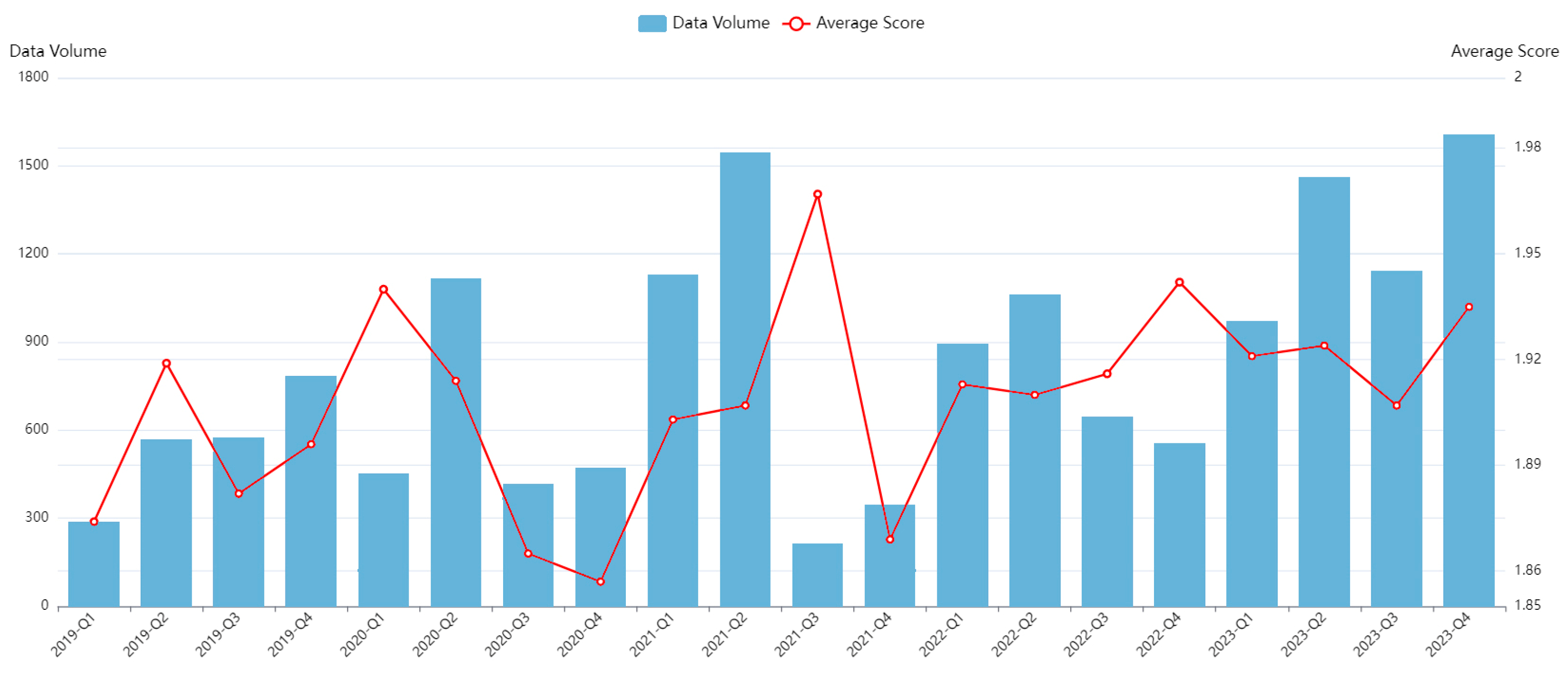
References
- Liu, Y.; Wang, R.; Xiao, Y.; Huang, B.; Chen, H.; Li, Z. Exploring the Linkage between Greenness Exposure and Depression among Chinese People: Mediating Roles of Physical Activity, Stress and Social Cohesion and Moderating Role of Urbanicity. Health Place 2019, 58, 102168. [Google Scholar] [CrossRef] [PubMed]
- Noszczyk, T.; Gorzelany, J.; Kukulska-Kozie, A.; Hernik, J. The Impact of the COVID-19 Pandemic on the Importance of Urban Green Spaces to the Public. Land Use Policy 2022, 113, 105925. [Google Scholar] [CrossRef] [PubMed]
- Zhu, Q.; Yao, P.; Li, J. The Effect of Nature-Based Landscape Design on Human Health and Well-Being: A Thematic Synthesis. J. Environ. Eng. Landsc. Manag. 2025, 33, 55–71. [Google Scholar] [CrossRef]
- Ha, J.; Kim, H.J.; With, K.A. Urban Green Space Alone Is Not Enough: A Landscape Analysis Linking the Spatial Distribution of Urban Green Space to Mental Health in the City of Chicago. Landscape Urban Plann. 2022, 218, 104309. [Google Scholar] [CrossRef]
- Neale, C.; Lopez, S.; Roe, J. Psychological Restoration and the Effect of People in Nature and Urban Scenes: A Laboratory Experiment. Sustainability 2021, 13, 6464. [Google Scholar] [CrossRef]
- Reyes-Riveros, R.; Altamirano, A.; De la Barrera, F.; Rozas-Vasquez, D.; Vieli, L.; Meli, P. Linking Public Urban Green Spaces and Human Well-Being: A Systematic Review. Urban For. Urban Green. 2021, 61, 127105. [Google Scholar] [CrossRef]
- Crețan, R.; Chasciar, D.; Dragan, A. Forests and Their Related Ecosystem Services: Visitors’ Perceptions in the Urban and Peri-Urban Spaces of Timișoara, Romania. Forests 2024, 15, 2177. [Google Scholar] [CrossRef]
- Peters, K. Being Together in Urban Parks: Connecting Public Space, Leisure, and Diversity. Leis. Sci. 2010, 32, 418–433. [Google Scholar] [CrossRef]
- Enssle, F.; Kabisch, N. Urban Green Spaces for the Social Interaction, Health and Well-Being of Older People-an Integrated View of Urban Ecosystem Services and Socio-Environmental Justice. Environ. Sci. Policy 2020, 109, 36–44. [Google Scholar] [CrossRef]
- Lai, S.; Deal, B. Parks, Green Space, and Happiness: A Spatially Specific Sentiment Analysis Using Microblogs in Shanghai, China. Sustainability 2023, 15, 146. [Google Scholar] [CrossRef]
- Jundi, W.; Zhiqiang, L.; Dawei, S.; Hui, Y. Knowledge Mapping Analysis of Foreign Urban Green Space Research Based on CiteSpace. Chin. Landsc. Archit. 2018, 34, 5–11. [Google Scholar]
- Beatley, T. Biophilic Cities. In Encyclopedia of Sustainability Science and Technology; Springer: New York, NY, USA, 2020; pp. 1–19. ISBN 978-1-4939-2493-6. [Google Scholar]
- Hofmann, M.; Westermann, J.R.; Kowarik, I.; Van der Meer, E. Perceptions of Parks and Urban Derelict Land by Landscape Planners and Residents. Urban For. Urban Green. 2012, 11, 303–312. [Google Scholar] [CrossRef]
- Li, X.-P.; Fan, S.-X.; Kühn, N.; Dong, L.; Hao, P.-Y. Residents’ Ecological and Aesthetical Perceptions toward Spontaneous Vegetation in Urban Parks in China. Urban For. Urban Green. 2019, 44, 126397. [Google Scholar] [CrossRef]
- Liu, Q.; Zhu, Z.; Zeng, X.; Zhuo, Z.; Ye, B.; Fang, L.; Huang, Q.; Lai, P. The Impact of Landscape Complexity on Preference Ratings and Eye Fixation of Various Urban Green Space Settings. Urban For. Urban Green. 2021, 66, 127411. [Google Scholar] [CrossRef]
- Liu, W.; Tsao, C.; Lin, C. Tourists’ Preference for Colors of Forest Landscapes and Its Implications for Forest Landscape Planning Policies. For. Policy Econ. 2023, 147, 102887. [Google Scholar] [CrossRef]
- Tan, C.; Chen, W.Y.; Su, Y.; Fritsch, A.; Canu, P.; Cao, Y.; Vazhayil, A.M.; Wantzen, K.M. Wild or Neat? Personal Traits Affect Public Preference for Wildness of Urban Lakeshores in France and China. Landsc. Urban Plann. 2024, 252, 105190. [Google Scholar] [CrossRef]
- Zhang, G.; Wu, G. Interactive Influence of the Perceived Visual Richness, Greenness and Scenography on Landscape Preference of Urban Woodland. J. Environ. Psychol. 2025, 103, 102586. [Google Scholar] [CrossRef]
- Ren, W.; Zhan, K.; Chen, Z.; Hong, X.-C. Research on Landscape Perception of Urban Parks Based on User-Generated Data. Buildings 2024, 14, 2776. [Google Scholar] [CrossRef]
- Li, X.; Pang, W.; Han, L.; Yan, Y.; Pan, X.; Yang, D. Relationship between Landscape Character and Public Preferences in Urban Landscapes: A Case Study from the East–West Mountain Region in Wuhan, China. Land 2025, 14, 1228. [Google Scholar] [CrossRef]
- McKitrick, M.K.; Schuurman, N.; Crooks, V.A. Collecting, Analyzing, and Visualizing Location-Based Social Media Data: Review of Methods in GIS-Social Media Analysis. Geojournal 2023, 88, 1035–1057. [Google Scholar] [CrossRef]
- Hausmann, A.; Toivonen, T.; Slotow, R.; Tenkanen, H.; Moilanen, A.; Heikinheimo, V.; Di Minin, E. Social Media Data Can Be Used to Understand Tourists’ Preferences for Nature-Based Experiences in Protected Areas. Conserv. Lett. 2018, 11, e12343. [Google Scholar] [CrossRef]
- Grzyb, T.; Kulczyk, S. How Do Ephemeral Factors Shape Recreation along the Urban River? A Social Media Perspective. Landsc. Urban Plann. 2023, 230, 104638. [Google Scholar] [CrossRef]
- Liu, S.; Su, C.; Zhang, J.; Takeda, S.; Liu, J.; Yang, R. Cross-Cultural Comparison of Urban Green Space through Crowdsourced Big Data: A Natural Language Processing and Image Recognition Approach. Land 2023, 12, 767. [Google Scholar] [CrossRef]
- Helbich, M.; Yao, Y.; Liu, Y.; Zhang, J.; Liu, P.; Wang, R. Using Deep Learning to Examine Street View Green and Blue Spaces and Their Associations with Geriatric Depression in Beijing, China. Environ. Int. 2019, 126, 107–117. [Google Scholar] [CrossRef] [PubMed]
- Zheng, Y.; Zhu, J.; Wang, S.; Guo, P. Perceived Economic Values of Cultural Ecosystem Services in Green and Blue Spaces of 98 Urban Wetland Parks in Jiangxi, China. Forests 2023, 14, 273. [Google Scholar] [CrossRef]
- Song, Y.; Ning, H.; Ye, X.; Chandana, D.; Wang, S. Analyze the Usage of Urban Greenways through Social Media Images and Computer Vision. Environ. Plann. B Urban Anal. City Sci. 2022, 49, 1682–1696. [Google Scholar] [CrossRef]
- Li, Y.; Qiu, B. Using Deep Learning Approaches to Quantify Landscape Preference of the Chinese Grand Canal: An Empirical Case Study of the Yangzhou Ancient Canal. Sustainability 2024, 16, 3602. [Google Scholar] [CrossRef]
- Ma, X.; Qiu, H. A Study on Landscape Image and Public Perception and Preferences of Lake Parks Based on Internet Photo Data and Auto ML Model. Chin. Landsc. Archit. 2022, 38, 86–91. [Google Scholar] [CrossRef]
- Zhang, J.; Li, D.; Ning, S.; Furuya, K. Sustainable Urban Green Blue Space (UGBS) and Public Participation: Integrating Multisensory Landscape Perception from Online Reviews. Land 2023, 12, 1360. [Google Scholar] [CrossRef]
- Zhou, C.; Zhang, S.; Zhao, M.; Wang, L.; Chen, J.; Liu, B. Investigating the Dynamicity of Sentiment Predictors in Urban Green Spaces: A Machine Learning-Based Approach. Urban For. Urban Green. 2023, 89, 128130. [Google Scholar] [CrossRef]
- Huang, W.; Zhao, X.; Lin, G.; Wang, Z.; Chen, M. How to Quantify Multidimensional Perception of Urban Parks? Integrating Deep Learning-Based Social Media Data Analysis with Questionnaire Survey Methods. Urban For. Urban Green. 2025, 107, 128754. [Google Scholar] [CrossRef]
- Luo, J.; Lei, Z.; Hu, Y.; Wang, M.; Cao, L. Analysis of Tourists’ Sentiment Tendency in Urban Parks Based on Deep Learning: A Case Study of Tianjin Water Park. Chin. Landsc. Archit. 2021, 37, 65–70. [Google Scholar] [CrossRef]
- Zhang, W.; Yoshida, T.; Tang, X. A Comparative Study of TF* IDF, LSI and Multi-Words for Text Classification. Expert Syst. Appl. 2011, 38, 2758–2765. [Google Scholar] [CrossRef]
- Salton, G.; McGill, M.J. Modern Information Retrieval; McGraw-Hill Book Company: New York, NY, USA, 1983. [Google Scholar]
- Haviland-Jones, J.; Rosario, H.H.; Wilson, P.; McGuire, T.R. An Environmental Approach to Positive Emotion: Flowers. Evol. Psychol. 2005, 3, 147470490500300109. [Google Scholar] [CrossRef]
- Todorova, A.; Asakawa, S.; Aikoh, T. Preferences for and Attitudes towards Street Flowers and Trees in Sapporo, Japan. Landscape Urban Plann. 2004, 69, 403–416. [Google Scholar] [CrossRef]
- Li, J.; Dai, G.; Tang, J.; Chen, Y. Conceptualizing Festival Attractiveness and Its Impact on Festival Hosting Destination Loyalty: A Mixed Method Approach. Sustainability 2020, 12, 3082. [Google Scholar] [CrossRef]
- Liu, C.; Wang, T.-Y.; Yuizono, T. Assessing the Landscape Visual Quality of Urban Green Spaces with Multidimensional Visual Indicators. Urban For. Urban Green. 2025, 106, 128727. [Google Scholar] [CrossRef]
- Wan, C.; Shen, G.Q.; Choi, S. Eliciting Users’ Preferences and Values in Urban Parks: Evidence from Analyzing Social Media Data from Hong Kong. Urban For. Urban Green. 2021, 62, 127172. [Google Scholar] [CrossRef]
- Komossa, F.; Wartmann, F.M.; Kienast, F.; Verburg, P.H. Comparing Outdoor Recreation Preferences in Peri-Urban Landscapes Using Different Data Gathering Methods. Landsc. Urban Plan. 2020, 199, 103796. [Google Scholar] [CrossRef]
- Guan, C.; Song, J.; Keith, M.; Zhang, B.; Akiyama, Y.; Da, L.; Shibasaki, R.; Sato, T. Seasonal Variations of Park Visitor Volume and Park Service Area in Tokyo: A Mixed-Method Approach Combining Big Data and Field Observations. Urban For. Urban Green. 2021, 58, 126973. [Google Scholar] [CrossRef]
- Liang, H.; Zhang, Q. Temporal and Spatial Assessment of Urban Park Visits from Multiple Social Media Data Sets: A Case Study of Shanghai, China. J. Clean. Prod. 2021, 297, 126682. [Google Scholar] [CrossRef]
- Roberts, H.; Sadler, J.; Chapman, L. Using Twitter to Investigate Seasonal Variation in Physical Activity in Urban Green Space. Geo Geogr. Environ. 2017, 4, e00041. [Google Scholar] [CrossRef]
- Kovacs-Györi, A.; Ristea, A.; Kolcsar, R.; Resch, B.; Crivellari, A.; Blaschke, T. Beyond Spatial Proximity—Classifying Parks and Their Visitors in London Based on Spatiotemporal and Sentiment Analysis of Twitter Data. ISPRS Int. J. Geo Inf. 2018, 7, 378. [Google Scholar] [CrossRef]
- Ullah, H.; Wan, W.; Haidery, S.A.; Khan, N.U.; Ebrahimpour, Z.; Muzahid, A.A.M. Spatiotemporal Patterns of Visitors in Urban Green Parks by Mining Social Media Big Data Based upon WHO Reports. IEEE Access 2020, 8, 39197–39211. [Google Scholar] [CrossRef]
- Song, Y.; Fernandez, J.; Wang, T. Understanding Perceived Site Qualities and Experiences of Urban Public Spaces: A Case Study of Social Media Reviews in Bryant Park, New York City. Sustainability 2020, 12, 8036. [Google Scholar] [CrossRef]
- Huai, S.; Van de Voorde, T. Which Environmental Features Contribute to Positive and Negative Perceptions of Urban Parks? A Cross-Cultural Comparison Using Online Reviews and Natural Language Processing Methods. Landsc. Urban Plan. 2022, 218, 104307. [Google Scholar] [CrossRef]
- Nakarmi, G.; Strager, M.P.; Yuill, C.; Moreira, J.C.; Burns, R.C.; Butler, P. Assessing Public Preferences of Landscape and Landscape Attributes: A Case Study of the Proposed Appalachian Geopark Project in West Virginia, USA. Geoheritage 2023, 15, 85. [Google Scholar] [CrossRef]
- Sun, X.; Shi, Y. The Image Recognition of Urban Greening Tree Species Based on Deep Learning and CAMP-MKNet Model. Urban For. Urban Green. 2023, 85, 127970. [Google Scholar] [CrossRef]
- Huai, S.; Liu, S.; Zheng, T.; Van de Voorde, T. Are Social Media Data and Survey Data Consistent in Measuring Park Visitation, Park Satisfaction, and Their Influencing Factors? A Case Study in Shanghai. Urban For. Urban Green. 2023, 81, 127869. [Google Scholar] [CrossRef]
- Chen, Y.; Liu, X.; Gao, W.; Wang, R.Y.; Li, Y.; Tu, W. Emerging Social Media Data on Measuring Urban Park Use. Urban For. Urban Green. 2018, 31, 130–141. [Google Scholar] [CrossRef]
- Dao, C.; Qi, J. Seeing and Thinking about Urban Blue–Green Space: Monitoring Public Landscape Preferences Using Bimodal Data. Buildings 2024, 14, 1426. [Google Scholar] [CrossRef]
- Qi, Z.; Duan, J.; Su, H.; Fan, Z.; Lan, W. Using Crowdsourcing Images to Assess Visual Quality of Urban Landscapes: A Case Study of Xiamen Island. Ecol. Indic. 2023, 154, 110793. [Google Scholar] [CrossRef]
- Richards, D.R.; Tuncer, B. Using Image Recognition to Automate Assessment of Cultural Ecosystem Services from Social Media Photographs. Ecosyst. Serv. 2018, 31, 318–325. [Google Scholar] [CrossRef]
- Zhu, X.; Gao, M.; Zhang, R.; Zhang, B. Quantifying Emotional Differences in Urban Green Spaces Extracted from Photos on Social Networking Sites: A Study of 34 Parks in Three Cities in Northern China. Urban For. Urban Green. 2021, 62, 127133. [Google Scholar] [CrossRef]
- Waterloo, S.F.; Baumgartner, S.E.; Peter, J.; Valkenburg, P.M. Norms of Online Expressions of Emotion: Comparing Facebook, Twitter, Instagram, and WhatsApp. New Media Soc. 2018, 20, 1813–1831. [Google Scholar] [CrossRef] [PubMed]
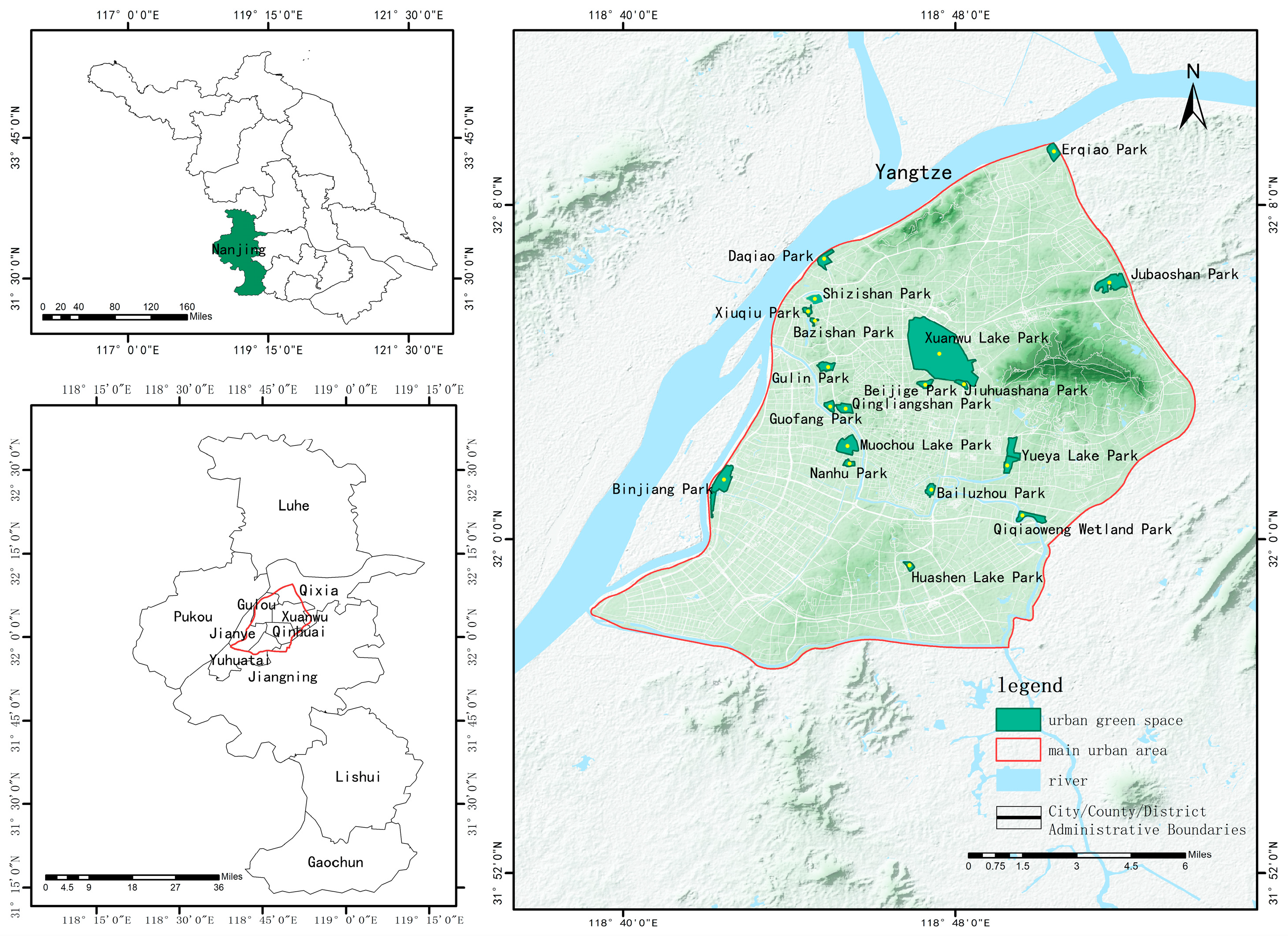

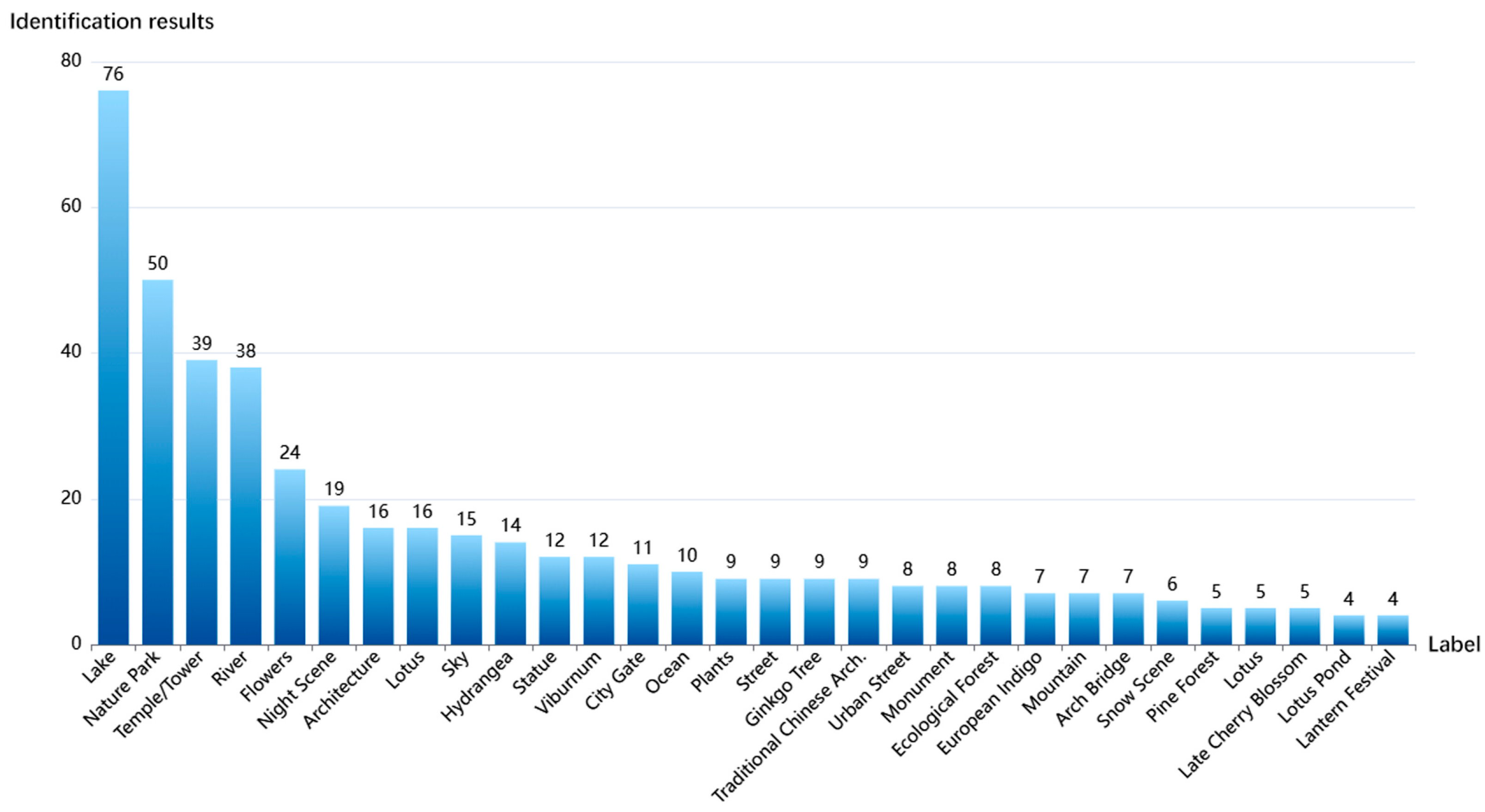

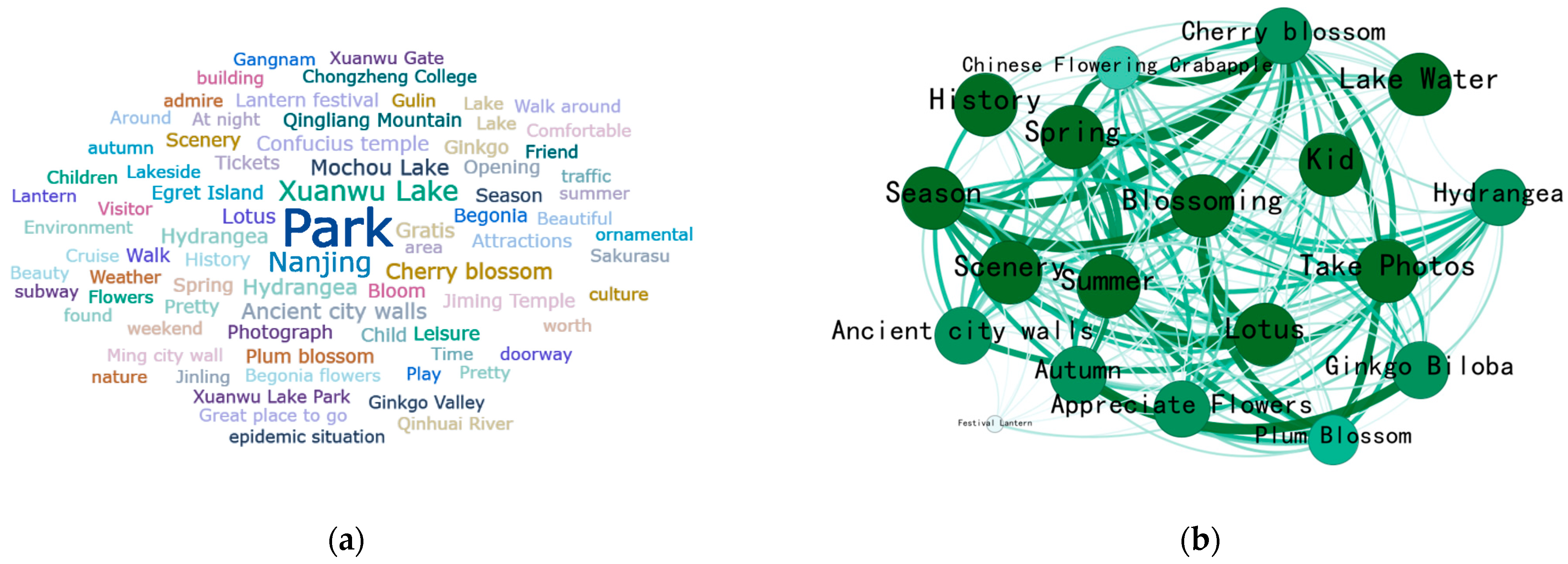
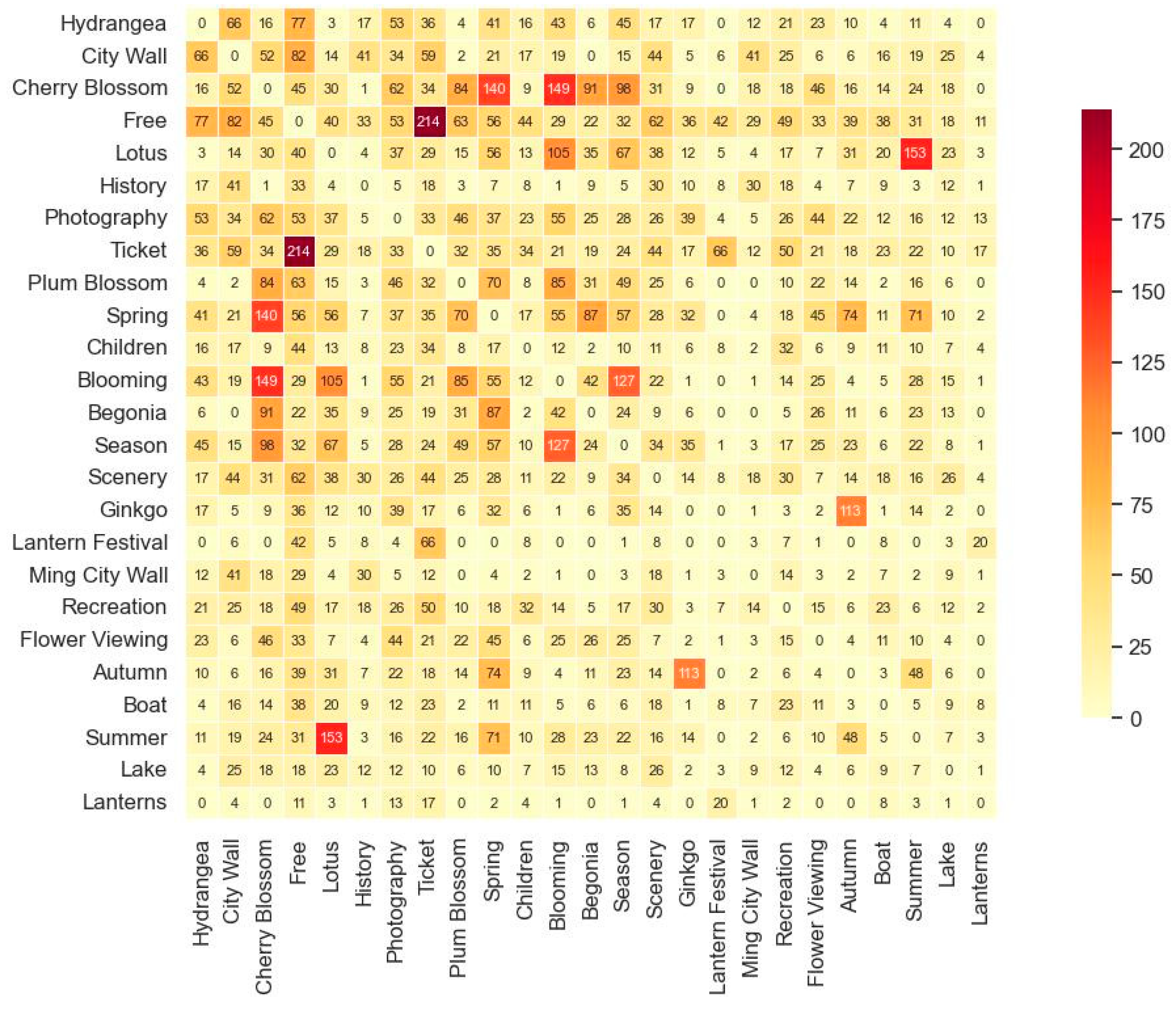
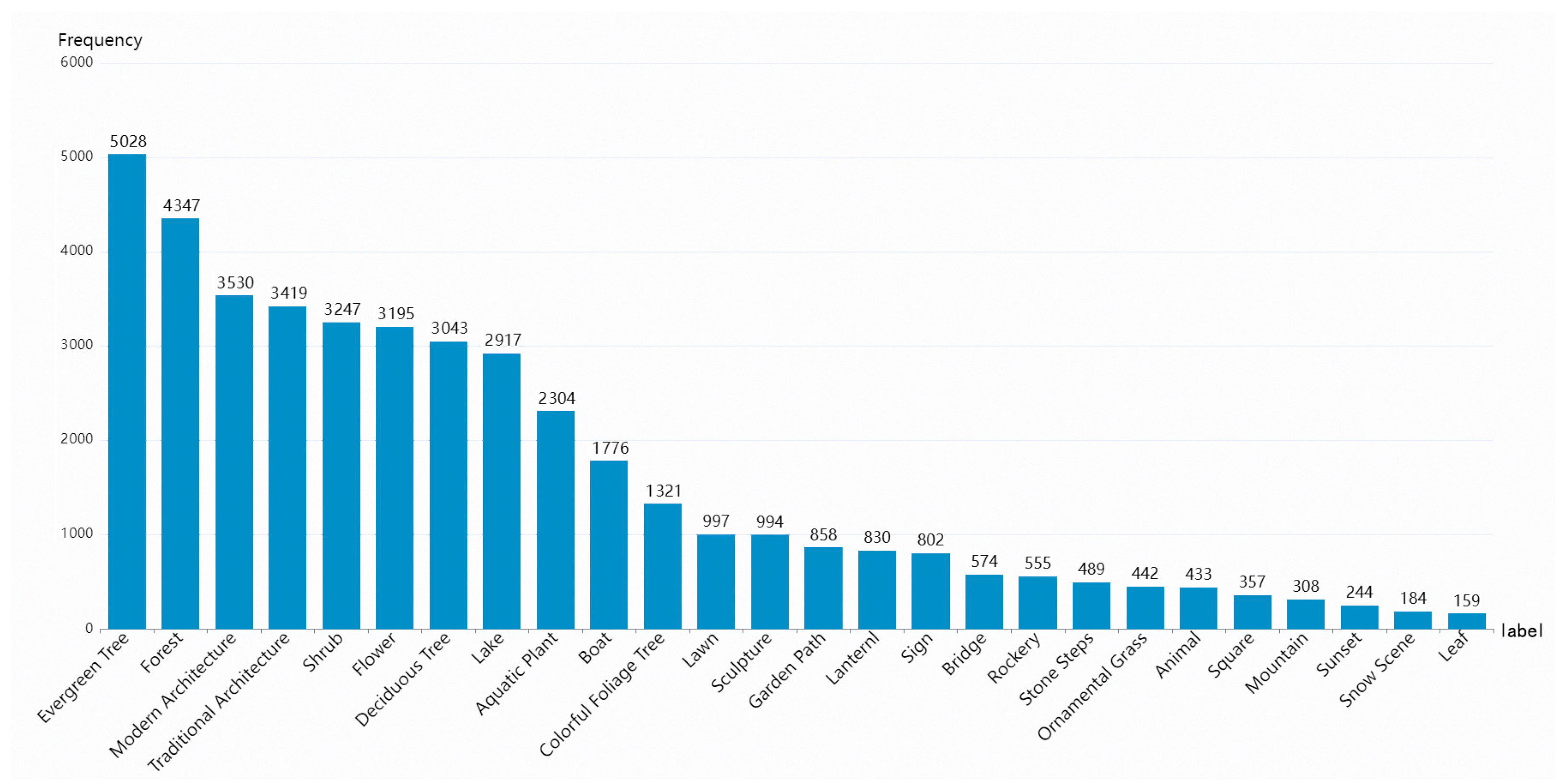


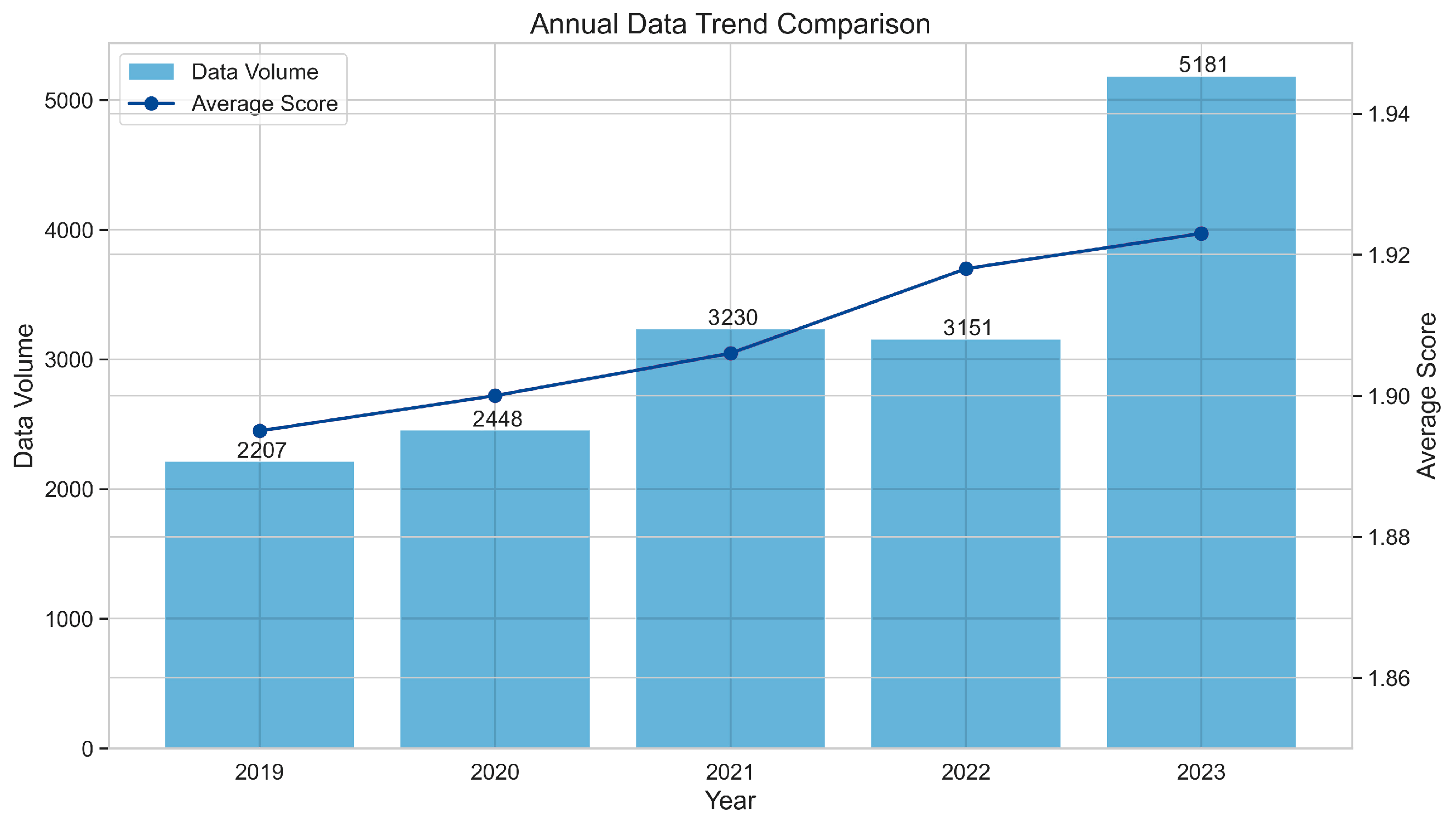
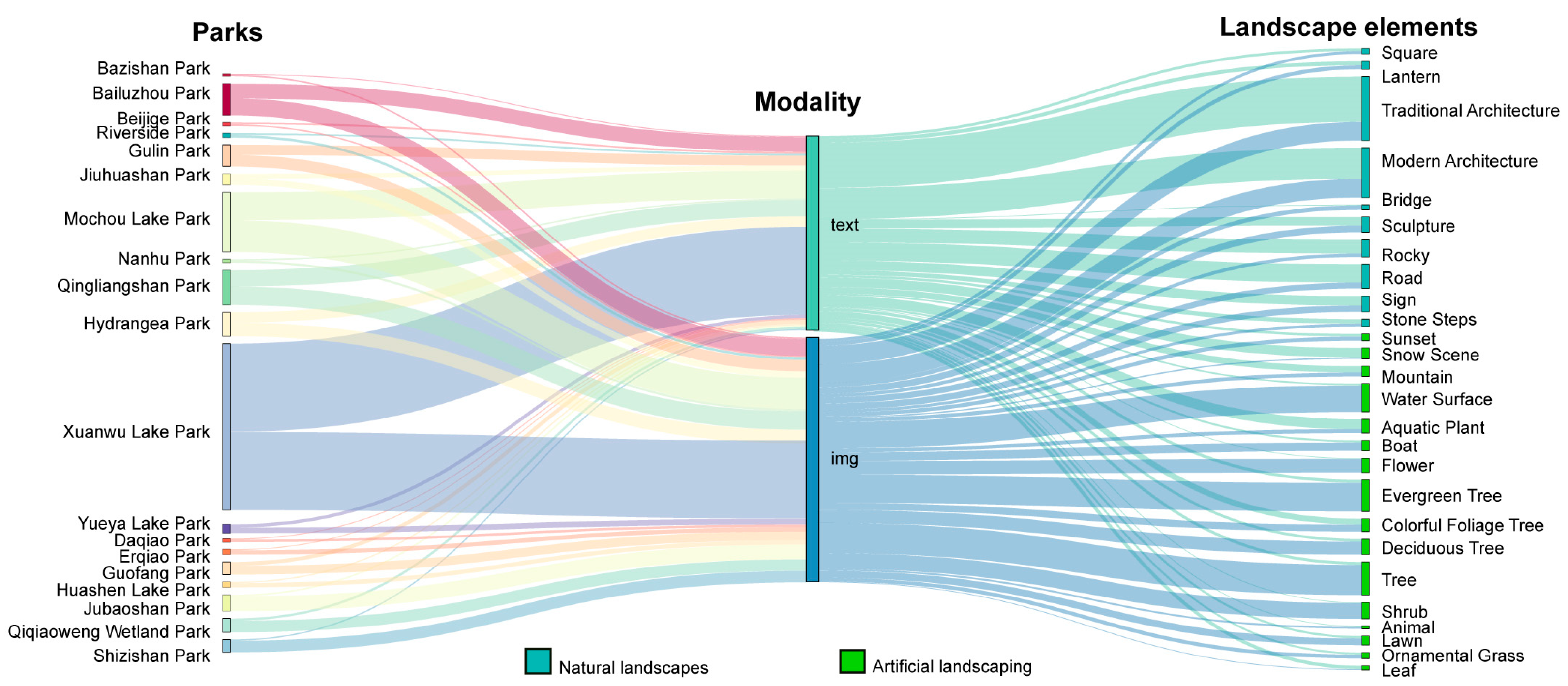
| Landscape Type | Landscape Elements |
|---|---|
| Buildings and structures | Square |
| Sculpture | |
| Stone steps | |
| Sign | |
| Modern architecture | |
| Garden path | |
| Historical and cultural landscape | Traditional architecture |
| Rockery | |
| Lantern | |
| Lake | Lake |
| Aquatic plant | |
| Boat | |
| Bridge | |
| Trees | Deciduous tree |
| Evergreen tree | |
| Tree with colorful foliage | |
| Forest | |
| Shrubs and ground cover | Shrub |
| Lawn | |
| Ornamental grass | |
| Ecology and natural elements | Animal |
| Flower | |
| Leaf | |
| Snow scene | |
| Mountain | |
| Sunset |
| Landscape Type | High-Frequency Words | TF–IDF Keywords |
|---|---|---|
| Buildings and structures | City Wall (1516), Fuzimiao (878), Evening (353), Jiming Temple (354) | Sunrise (0.41), Traditional Architecture (0.38), Annual Event (0.40), Ticket Price (0.40) |
| Historical and cultural landscape | City Wall (1516), Lantern Festival (1027), Fuzimiao (878), Chongzheng Academy (470) | Lantern Viewing (0.42), Traces (0.38), Biaoying Gate (0.37), City Wall (0.37) |
| Lake | Xuanwu Lake (2472), Lotus (1274), Boat Ride (771), Lake Surface (825) | Wild Duck (0.42), Temple (0.40), White Goose (0.40), Animals (0.39) |
| Trees | Cherry Blossom (1414), Xuanwu Lake (1051), Ginkgo (788), Ginkgo Valley (417) | Lush (0.50), Cherry Blossom (0.44), Bare (0.37), Clustered (0.37), Withered (0.37) |
| Shrubs and ground cover | Leisure (645), Picnic (226), Lawn (179), Stroll (158) | Leisure Activities (0.49), Entertainment Activities (0.46), Spring Scenery (0.43), Sightseeing (0.42), Spacious (0.42) |
| Ecology and natural elements | Hydrangea (3134), Cherry Blossom (1420), Lotus (1274), Plum Blossom (1005) | Cherry Blossom (0.46), Large Bloom (0.40), Fully Bloomed (0.39), Annual Event (0.38), Very Beautiful (0.38) |
| Landscape Element | Text-Image Cosine Similarity | Permutation Test p-Value |
|---|---|---|
| Sunset | 0.621452936 | 0.0000 *** |
| Lantern | 0.571547607 | 0.0000 *** |
| Lake | 0.544487647 | 0.0000 *** |
| Flower | 0.494947497 | 0.0000 *** |
| Snow scene | 0.385077023 | 0.0000 *** |
| Hydrophyte | 0.379151178 | 0.0000 *** |
| Boat | 0.305930467 | 0.0000 *** |
| Traditional architecture | 0.296463079 | 0.0035 *** |
| Evergreen tree | 0.23094034 | 0.4748 |
| Bridge | 0.185115044 | 0.0000 *** |
| Sculpture | 0.174247953 | 0.0000 *** |
| Shrub | 0.163401599 | 0.6577 |
| Modern architecture | 0.160853151 | 0.3083 |
| Tree with colorful foliage | 0.150869694 | 0.0000 *** |
| Animal | 0.14767623 | 0.0000 *** |
| Deciduous tree | 0.100453201 | 0.0634 * |
| Forest | 0.0961696 | 0.0196 ** |
| Lawn | 0.091522758 | 0.1015 |
| Mountain | 0.074319697 | 0.3561 |
| Garden path | 0.065543129 | 0.3860 |
| Sign | 0.056493268 | 0.6219 |
| Stone | 0.055066732 | 0.1002 |
| Ornamental grass | 0.052680244 | 0.1165 |
| Rockery | 0.038807526 | 0.5656 |
| Square | 0.033113309 | 0.6007 |
| Leaf | 0.032826608 | 0.4056 |
Disclaimer/Publisher’s Note: The statements, opinions and data contained in all publications are solely those of the individual author(s) and contributor(s) and not of MDPI and/or the editor(s). MDPI and/or the editor(s) disclaim responsibility for any injury to people or property resulting from any ideas, methods, instructions or products referred to in the content. |
© 2025 by the authors. Licensee MDPI, Basel, Switzerland. This article is an open access article distributed under the terms and conditions of the Creative Commons Attribution (CC BY) license (https://creativecommons.org/licenses/by/4.0/).
Share and Cite
Yan, J.; Zhang, F.; Qiu, B. Cross-Modal Insights into Urban Green Spaces Preferences. Buildings 2025, 15, 2563. https://doi.org/10.3390/buildings15142563
Yan J, Zhang F, Qiu B. Cross-Modal Insights into Urban Green Spaces Preferences. Buildings. 2025; 15(14):2563. https://doi.org/10.3390/buildings15142563
Chicago/Turabian StyleYan, Jiayi, Fan Zhang, and Bing Qiu. 2025. "Cross-Modal Insights into Urban Green Spaces Preferences" Buildings 15, no. 14: 2563. https://doi.org/10.3390/buildings15142563
APA StyleYan, J., Zhang, F., & Qiu, B. (2025). Cross-Modal Insights into Urban Green Spaces Preferences. Buildings, 15(14), 2563. https://doi.org/10.3390/buildings15142563





